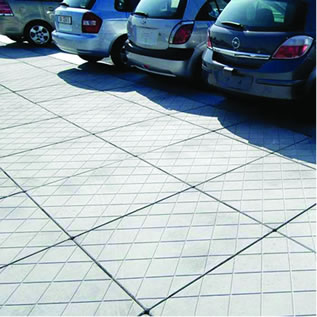
Stormwater management solutions and flexible design
As the population continues to grow and our cities are ever expanding, providing a considered approach to water management during project design is increasingly important. If we do not prioritise and manage water and water quality more effectively, then, in the not too distant future, we will not have enough water to sustain the environment and life.
On average, a non-domestic building uses approximately 2,600L of water per day, with up to 80% of potable water delivered for non potable use, such as flushing toilets and urinals. This poses a real threat to the sustainable supply of essential clean drinking water, so it is more important than ever to conserve and manage water in and around today’s buildings.
A non-domestic building uses around 2,600L of water per day
Modular rainwater component systems can be used to create effective and sustainable building water management systems. Sustainable drainage systems (SuDS) not only reduce run off from rainfall, they can also add value by using the rainwater as a resource, treating the surface water run off to reduce pollution and help make space for water enhancing both biodiversity and amenity.
The majority of rainfall events in the UK are very small in depth, typically less than 5mm. This water can be easily intercepted and captured for re-use within the site boundary at shallower depths.
Shallow installations offer major benefits against traditional drainage installations. In built-up city environments, for example, the space in which water management solutions can be utilised is limited due to the proximity of neighbouring developments, with the building’s footprint sometimes providing the only space in which to work.
Geocellular systems ideal for storing rainwater
Plastic geocellular systems can be used to create shallow structural water reservoirs. These geocellular systems, consisting of lightweight, robust modular cells, are interlocked to create a load-supporting raft below any hardstanding area. As well as having the innate strength to cope with trafficked loads, geocellular systems incorporate a high void ratio, typically 95%, and can provide rainwater storage, attenuation and infiltration.
Geocellular systems are capable of collecting and retaining almost three times more water than a typical aggregate sub-base, providing a vital first stage in the process of water management helping developers, designers and contractors provide solutions that can intercept rainwater at source, on roofs, podiums and any hardstanding areas within the site boundary.
Shallow installations are a suitable alternative to traditional drainage systems
Source control allows the run-off flow rates from the building and site-wide drainage system to be managed more effectively, using above and below ground-flow control devices to mimic the natural flow of water and reduce the impact on downstream flooding.
Infiltration is used as much as possible, allowing the rainwater to naturally soak into the ground and encouraging natural groundwater recharge (where applicable).
It is possible to harvest and treat rainwater for re-use, supplying non-potable outlets such as WC and urinal flushing cisterns, laundry and vehicle washing and irrigation.
The development of new geotextiles allows designers to manage pollution at its source and protect natural water resources from both diffuse and point pollution (accidental spills, for example). Therefore, it is possible to protect and enhance water quality and help architects and landscape designers create a natural environment within the urban landscape.
By involving manufactures at the concept design stage and drawing on their expertise, the design team can develop effective, engineered solutions for the management of rainfall and surface water based on current legislation and guidance to achieve real commercial and environmental benefits while complementing the individual building’s shape or available space on site.
Latest news

25th March 2025
Reduce sound transference with West Fraser CaberAcoustic
CaberAcoustic from West Fraser is a highly versatile, effective and economical sound-reducing flooring solution. Reducing both impact and airborne transmitted sounds, it can be laid over concrete and timber floors in both new and existing buildings.
Posted in Acoustics, Noise & Vibration Control, Articles, Building Industry News, Building Products & Structures, Building Services, Building Systems, Facility Management & Building Services, Floors, Interior Design & Construction, Interiors, Posts, Restoration & Refurbishment, Retrofit & Renovation, Timber Buildings and Timber Products
25th March 2025
Vent-Axia Kicks Off Charity Football Tournament in Support of Cancer Research UK
Ventilation leader Vent-Axia brought together leading building design professionals for an action-packed Charity Powerleague 5-a-side Football Tournament on Thursday 20th March in Shoreditch, London, in aid of Cancer Research UK.
Posted in Air Conditioning, Articles, Building Industry Events, Building Industry News, Building Products & Structures, Building Services, Charity work, Facility Management & Building Services, Heating, Ventilation and Air Conditioning - HVAC
25th March 2025
Jane Elvins bolsters GEZE UK Specification team
GEZE UK, a leading manufacturer and provider of door, window and access control systems, is delighted to welcome Jane Elvins, who joins as Specification and Business Development Manager.
Posted in Access Control & Door Entry Systems, Architectural Ironmongery, Articles, Building Industry News, Building Products & Structures, Building Services, Doors, Facility Management & Building Services, Recruitment, Retrofit & Renovation, Security and Fire Protection, Windows
24th March 2025
Putting Glidevale Protect in the frame at InverTay Homes development
Leading building products manufacturer Glidevale Protect is supplying its construction and roofing membranes for a new timber frame housing development currently being constructed by InverTay Homes in Dundee.
Posted in Articles, Building Industry News, Building Products & Structures, Building Services, Building Systems, Case Studies, Facility Management & Building Services, Membranes, Restoration & Refurbishment, Retrofit & Renovation, Roofs, Sustainability & Energy Efficiency, Timber Buildings and Timber Products, Walls
 Sign up:
Sign up: